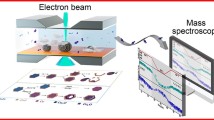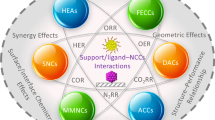Abstract
The search for alternative earth abundant semiconducting nanocrystals for sustainable energy applications has brought forth the need for nanoscale syntheses beyond bulk synthesis routes. Of particular interest are metal phosphides and derivative I–V–VI chalcogenides including copper phosphide (Cu3P) and copper thiophosphate (Cu3PS4). Herein, we report a one-pot, solution-based synthesis of Cu3P nanocrystals utilizing an in situ phosphorus source: phosphorus pentasulfide (P2S5) in trioctylphosphine. By injecting this phosphorus source into a copper solution in oleylamine, uniform and size controlled Cu3P nanocrystals with a phosphorous-rich surface are synthesized. The subsequent reaction of the Cu3P nanocrystals with decomposing thiourea forms nanoscale Cu3PS4 particles having p-type conductivity and an effective optical band gap of 2.36 eV. The synthesized Cu3PS4 produces a cathodic photocurrent during photoelectrochemical measurements, demonstrating its application as a light-absorbing material. Our process creates opportunities to explore other solution-based metal-phosphorus systems and their subsequent sulfurization for earth abundant, alternative energy materials.







Similar content being viewed by others
References
S.L. Brock and K. Senevirathne: Recent developments in synthetic approaches to transition metal phosphide nanoparticles for magnetic and catalytic applications. J. Solid State Chem. 181, 1552–1559 (2008).
S.T. Oyama, T. Gott, H. Zhao, and Y-K. Lee: Transition metal phosphide hydroprocessing catalysts: A review. Catal. Today 143, 94–107 (2009).
J. Wang, Q. Yang, Z. Zhang, T. Li, and S. Zhang: Synthesis of InP nanofibers from tri(m-tolyl)phosphine: An alternative route to metal phosphide nanostructures. Dalton Trans. 39, 227–233 (2010).
H. Pfeiffer, F. Tancret, and T. Brousse: Synthesis, characterization and electrochemical properties of copper phosphide (Cu3P) thick films prepared by solid-state reaction at low temperature: A probable anode for lithium ion batteries. Electrochim. Acta, 50, 4763–4770 (2005).
M.C. Stan, R. Klöpsch, A. Bhaskar, J. Li, S. Passerini, and M. Winter: Cu3P binary phosphide: Synthesis via a wet mechanochemical method and electrochemical behavior as negative electrode material for lithium-ion batteries. Adv. Energy Mater. 3, 231–238 (2013).
C. Villevieille, F. Robert, P.L. Taberna, L. Bazin, P. Simon, and L. Monconduit: The good reactivity of lithium with nanostructured copper phosphide. J. Mater. Chem. 18, 5956 (2008).
J.A. Aitken, V. Ganzha-Hazen, and S.L. Brock: Solvothermal syntheses of Cu3P via reactions of amorphous red phosphorus with a variety of copper sources. J. Solid State Chem. 178, 970–975 (2005).
Y. Xie, H.L. Su, X.F. Qian, X.M. Liu, and Y.T. Qian: A mild one-step solvothermal route to metal phosphides (metal = Co, Ni, Cu). J. Solid State Chem. 91, 88–91 (2000).
S. Carenco, Y. Hu, I. Florea, O. Ersen, C. Boissie, N. Me, and C. Sanchez: Metal-dependent interplay between crystallization and phosphorus diffusion during the synthesis of metal phosphide nanoparticles. Chem. Mater. 24, 4134–4145 (2012).
J. Park, B. Koo, K.Y. Yoon, Y. Hwang, M. Kang, J-G. Park, and T. Hyeon: Generalized synthesis of metal phosphide nanorods via thermal decomposition of continuously delivered metal-phosphine complexes using a syringe pump. J. Am. Chem. Soc. 127, 8433–8440 (2005).
A.E. Henkes, Y. Vasquez, and R.E. Schaak: Converting metals into phosphides: a general strategy for the synthesis of metal phosphide nanocrystals. J. Am. Chem. Soc. 129, 1896–1897 (2007).
A.E. Henkes and R.E. Schaak: A general phosphorus source for the low-temperature conversion of metals into metal phosphides. Chem. Mater. 19, 4234–4242 (2007).
L. De Trizio, A. Figuerola, L. Manna, A. Genovese, C. George, R. Brescia, Z. Saghi, R. Simonutti, M. Van Huis, and A. Falqui: Size tunable, hexagonal plate-like Cu3P and Janus-like Cu-Cu3P nanocrystals. ACS Nano 6, 32–41 (2012).
V. Itthibenchapong, R.S. Kokenyesi, A.J. Ritenour, L.N. Zakharov, S.W. Boettcher, J.F. Wager, and D.A. Keszler: Earth-abundant Cu-based chalcogenide semiconductors as photovoltaic absorbers. J. Mater. Chem. C 1, 657 (2013).
L. Yu, R.S. Kokenyesi, D.A. Keszler, and A. Zunger: Inverse design of high absorption thin-film photovoltaic materials. Adv. Energy Mater. 3, 43–48 (2013).
D.H. Foster, V. Jieratum, R. Kykyneshi, D.A. Keszler, and G. Schneider: Electronic and optical properties of potential solar absorber Cu3PSe4. Appl. Phys. Lett. 99, 181903 (2011).
R.B. Balow, E.J. Sheets, M.M. Abu-Omar, and R. Agrawal: Synthesis and characterization of copper arsenic sulfide nanocrystals from earth abundant elements for solar energy conversion. Chem. Mater. 27, 2290–2293 (2015).
R. Nitsche and P. Wild: Crystal growth of metal-phosphorus-sulfur compounds by vapor transport. Mater. Res. Bull. 5, 419–423 (1970).
J.V. Marzik, A.K. Hsieh, K. Dwight, and A. Wold: Photoelectronic properties of Cu3PS4 and Cu3PS3Se single crystals. J. Solid State Chem. 49, 43–50 (1983).
R. Blachnik, B. Gather, and E. Andrae: Ternary chalcogenide systems: the Quasiternary System Ag2S-Cu2S-P4S10. J. Therm. Anal. 37, 1289–1298 (1991).
H. Andrae: Metal sulphide-tetraphosphorusdekasulphide phase diagrams. J. Alloys Compd. 189, 209–215 (1992).
A. Pfitzner and S. Reiser: Refinement of the crystal structures of Cu3PS4 and Cu3SbS4 and a comment on normal tetahedral structures. Z. Kristallogr. 217, 51–54 (2002).
S. Uk Son, I. Kyu Park, J. Park, and T. Hyeon: Synthesis of Cu2O coated Cu nanoparticles and their successful applications to Ullmann-type amination coupling reactions of aryl chlorides. Chem. Commun. 1, 778–779 (2004).
S. Chen, X. Zhang, Q. Zhang, and W. Tan: Trioctylphosphine as both solvent and stabilizer to synthesize CdS nanorods. Nanoscale Res. Lett. 4, 1159–1165 (2009).
X. Hou, X. Zhang, S. Chen, Y. Fang, J. Yan, N. Li, and P. Qi: Facile synthesis of SERS active Ag nanoparticles in the presence of tri-n-octylphosphine sulfide. Appl. Surf. Sci. 257, 4935–4940 (2011).
O. Olofsson: The Crystal Structure of Cu3P. Acta Chem. Scand. 26, 2777–2787 (1972).
M.H. Mobarok and J.M. Buriak: Elucidating the surface chemistry of zinc phosphide nanoparticles through ligand exchange. Chem. Mater. 26(15), 4653 (2014).
L. De Trizio, R. Gaspari, G. Bertoni, I. Kriegel, L. Moretti, F. Scotognella, L. Maserati, Y. Zhang, G.C. Messina, M. Prato, S. Marras, A. Cavalli, and L. Manna: Cu3-xP nanocrystals as a material platform for near-infrared plasmonics and cation exchange reactions. Chem. Mater. 27, 1120–1128 (2015).
S. Wang, Q. Gao, and J. Wang: Thermodynamic analysis of decomposition of thiourea and thiourea oxides. J. Phys. Chem. B 109, 17281–17289 (2005).
V.P. Timchenko, A.L. Novozhilov, and O.A. Slepysheva: Kinetics of Thermal Decomposition of Thiourea. Russ. J. Gen. Chem. 74, 1046–1050 (2004).
T. Unold and L. Gütay: Photoluminescence analysis of thin-film solar cells. In Advanced Characterization Techniques for Thin Film Solar Cells, D. Abou-Ras, T. Kirchartz, and U. Rau eds.; Weinheim, Germany: Wiley-VCH Verlag GmbH & Co. KGaA, 2011; pp. 151–175.
ACKNOWLEDGMENTS
The authors would like to give special thanks to Karl Wood for his mass spectrometry assistance, and James Meyer for his experimental assistance. This work was supported by the National Science Foundation’s Solar Economy IGERT Grant No. 0903670. E.A.S. acknowledges support from the U.S. DOE Office of Science Facility at Brookhaven National Laboratory under Contract No. DE-SC0012704.
Author information
Authors and Affiliations
Corresponding author
Additional information
This author was an editor of this journal during the review and decision stage. For the JMR policy on review and publication of manuscripts authored by editors, please refer to http://www.mrs.org/jmr-editor-manuscripts/
Supplementary Material
43578_2015_30233710_MOESM1_ESM.docx
Supplemental Material: An In-situ Phosphorus Source for the Synthesis of Cu3P and the Subsequent Conversion to Cu3PS4 Nanoparticle Clusters (approximately 4.30 MB)
Rights and permissions
About this article
Cite this article
Sheets, E.J., Yang, WC., Balow, R.B. et al. An in situ phosphorus source for the synthesis of Cu3P and the subsequent conversion to Cu3PS4 nanoparticle clusters. Journal of Materials Research 30, 3710–3716 (2015). https://doi.org/10.1557/jmr.2015.333
Received:
Accepted:
Published:
Issue Date:
DOI: https://doi.org/10.1557/jmr.2015.333




